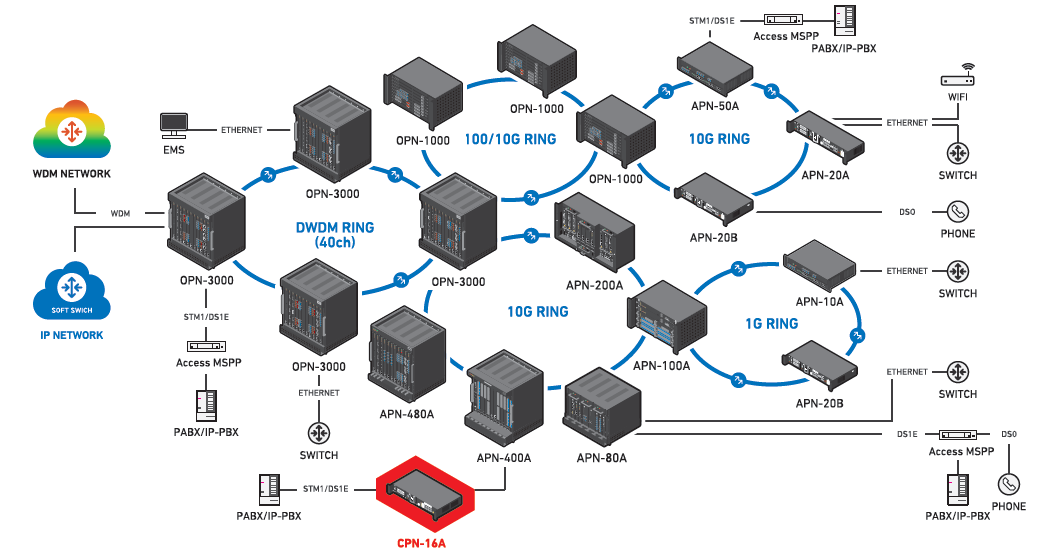Broadband Solution
Provider
Optical Transmission System
Packet Transport Network
It adopts standardized MPLS-TP OAM for management and protection switchover within 50ms. In addition, it offers GUI EMS and function of end to end service creation by one-click for easy operation and management.
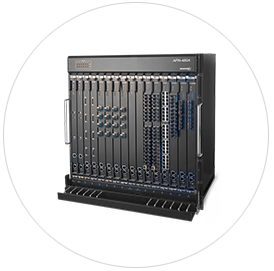
APN-480A
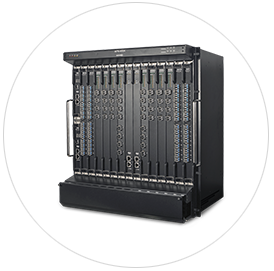
APN-400A
* APN : Advanced Packet Network
Specification
| Model | APN-480A |
APN-400A |
||
| Composition | Common part | Control part (2slot), Switching part (2slot) |
||
| Channel part | 12Slot, Universal Slot | 12Slot, Universal Slot | ||
Switching Capacity |
Packet | 480bps |
400Gbps |
|
Protection |
Network | MPLS-TP (G.8131) Linear Switching |
||
Service Interface | ||||
10GbE (XFP) |
48 Ports/Sys. (4 Ports/Unit) |
56 Port/Sys (4/8 Port/Unit) |
||
GbE-FX (SFP) |
480 Ports/Sys. (48 Ports/Unit) |
192 Port/Sys (16 Port/Unit) |
||
GbE-TX (RJ-45) |
480 Ports/Sys. (48 Ports/Unit) |
192 Port/Sys (16 Port/Unit) |
||
100Base-FX (SFP) |
480 Ports/Sys. (48 Ports/Unit) |
192 Port/Sys (16 Port/Unit) |
||
100Base-TX (RJ-45) |
480 Ports/Sys. (48 Ports/Unit) |
192 Port/Sys (16 Port/Unit) |
||
STM-1(CES) |
96 Ports/Sys. (8 Ports/Unit) |
32 Port/Ext. Sys (8 Port/Unit) |
||
DS1E (CES) |
384 Ports, (32 Ports/Unit) |
64 Port/Ext. Sys (16 Port/Unit) |
||
| Clock | INT / EXT / Sync-E / IEEE 1588v2 |
|||
Dimension |
W x H x D (mm) |
584.2x621.5x381.8 (incL FAN) |
482.5x534x381.8 (incL FAN) |
|
| Power Supply | DC/AC | -48VDC |
||
| Power Consumption (W) | 1,672 | 866 | ||
Advantages
- Continuity through function based on MPLS-TP standard technology
- · MPLS-TP Linear Protection (G.8131)
- · Protection switchover within 50ms
- Various services and flexible network topology
- · Ethernet interfaces (10GE, 1GE, FE), SDH and PDH interfaces(STM-1, E1)
- · Variety of topologies such as PTP, ring and mesh (G.8131 Linear protection)
- · Support PTN network based on MPLS-TP
- Optimized L2 function
- · UNI duplexing by setting 1 LAG of 2 units
- · Self loop detection for blocking looping obstruction of a port
- QoS for efficient traffic management
- · Maximization of bandwidth utilization by controlling CIR and PIR as 1 Mbps
- · Application of PHB MAP and QoS by CoS, DSCP setting
- · Quality control as services via offering 8 Queues per port
- Traffic statistics of services
- · Traffic management for each port and offering easier viewing graph of statistic information in database
- End to End service operating management
- · End to End service configuration by one click
- · Service configuration management by GUI
- Efficient operation
- · Direct monitoring and management with system configuration as like real equipment
- · Convenient functions including automatic creation of tunnel name, bandwidth variation, and path creation when network configuring
- System management
- · Offering statistical information on temperature of each unit and optical module function
- · Fan speed auto control function for efficient cooling of the equipment
Network Topology
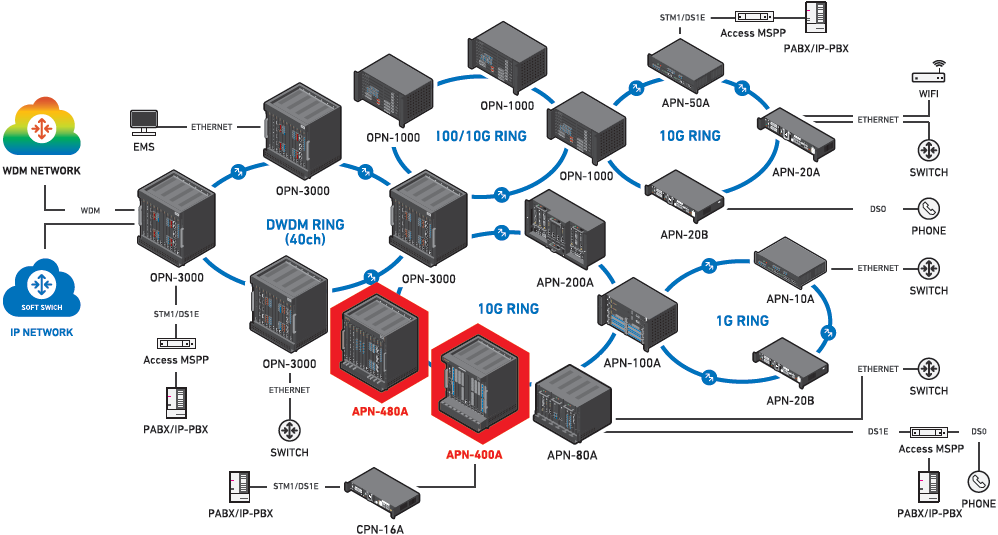
Packet Transport Network
It adopts standardized MPLS-TP OAM for management and protection switchover within 50ms. In addition, it offers GUI EMS and function of end to end service creation by one-click for easy operation and management.
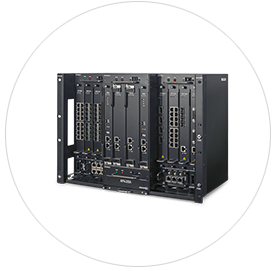
APN-200A
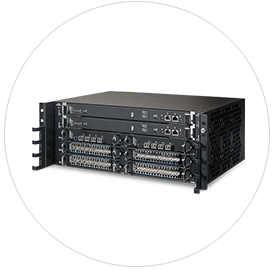
APN-100A
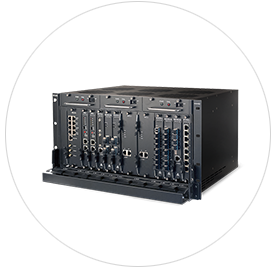
APN-80A
* APN : Advanced Packet Network
Specification
| Model | APN-200A |
APN-100A |
APN-80A |
|
| Composition | Common part | Control part (2slot), Switching part (2slot) |
||
| Channel part | 8Slot, Universal Slot | 6Slot, Universal Slot | 7Slot, Universal Slot | |
Switching Capacity |
Packet | 200Gbps |
100Gbps |
80Gbps |
Protection |
Network | MPLS-TP(G.8131) Linear Switching |
||
Service Interface | ||||
10GbE (XFP) |
32 Ports/Sys. (4 Ports/Unit) |
24 Ports/Sys. (4 Ports/Unit) |
14 Port/Sys (2 Port/Unit) |
|
GbE-FX (SFP) |
96 Ports/Sys. (16 Ports/Unit) |
56 Port/Sys (8 Port/Unit) | ||
GbE-TX (RJ-45) |
96 Ports/Sys. (16 Ports/Unit) |
56 Port/Sys (8 Port/Unit) | ||
100Base-FX (SFP) |
96 Ports/Sys. (16 Ports/Unit) |
56 Port/Sys (8 Port/Unit) | ||
100Base-TX (RJ-45) |
96 Ports/Sys. (16 Ports/Unit) |
56 Port/Sys (8 Port/Unit) | ||
STM-1(CES) |
24 Ports/Sys. (4 Ports/Unit) |
32 Port/Ext. Sys (8 Port/Unit) | 28 Port/Sys (4 Port/Unit) | |
| DS1E (CES) | 96 Ports/Sys. (16Ports/Unit) |
64 Port/Ext. Sys (16 Port/Unit) | 112 Port/Sys (16 Port/Unit) | |
| Clock | INT / EXT / Sync-E / IEEE 1588v2 |
|||
Dimension |
W x H x D (mm) |
482.5 x 354 x 290(incL FAN) |
482.5 x 177 x 381.8(incL FAN) |
482.5 x 266.4 x 381.8(incL FAN) |
| Power Supply | DC/AC | -48VDC |
||
| Power Consumption (W) | 394 | 385 | 213 | |
Advantages
- Continuity through function based on MPLS-TP standard technology
- · MPLS-TP Linear Protection (G.8131)
- · Protection switchover within 50ms
- Various services and flexible network topology
- · Ethernet interfaces (10GE, 1GE, FE), SDH and PDH interfaces(STM-1, E1)
- · Variety of topologies such as PTP, ring and mesh (G.8131 Linear protection)
- · Support PTN network based on MPLS-TP
- Optimized L2 function
- · UNI duplexing by setting 1 LAG of 2 units
- · Self loop detection for blocking looping obstruction of a port
- QoS for efficient traffic management
- · Maximization of bandwidth utilization by controlling CIR and PIR as 1 Mbps
- · Application of PHB MAP and QoS by CoS, DSCP setting
- · Quality control as services via offering 8 Queues per port
- Traffic statistics of services
- · Traffic management for each port and offering easier viewing graph of statistic information in database
- End to End service operating management
- · End to End service configuration by one click
- · Service configuration management by GUI
- Efficient operation
- · Direct monitoring and management with system configuration as like real equipment
- · Convenient functions including automatic creation of tunnel name, bandwidth variation, and path creation when network configuring
- System management
- · Offering statistical information on temperature of each unit and optical module function
- · Fan speed auto control function for efficient cooling of the equipment
Network Topology
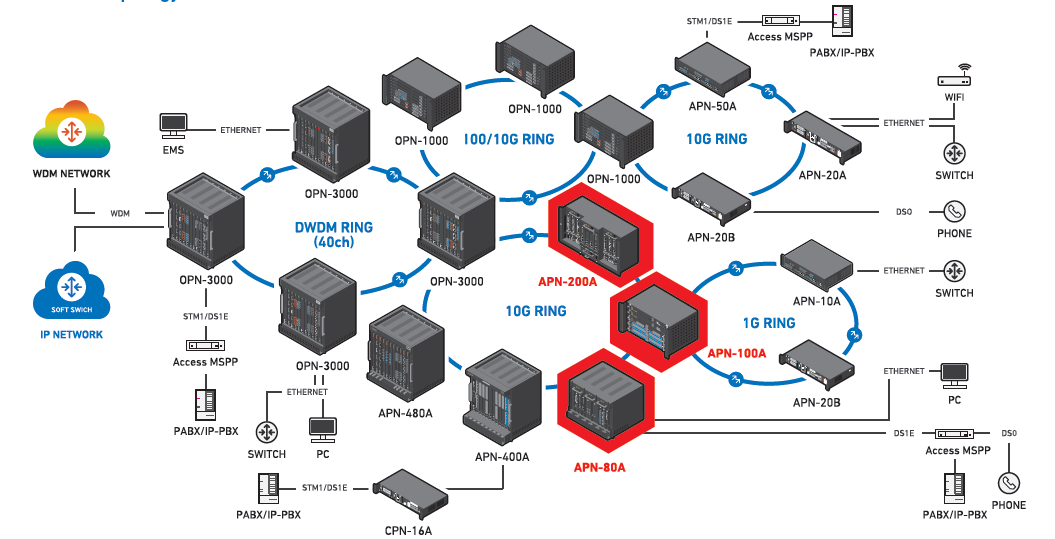
Packet Transport Network
It adopts standardized MPLS-TP OAM for management and protection switchover within 50ms. In addition, it offers GUI EMS and function of end to end service creation by one-click for easy operation and management.
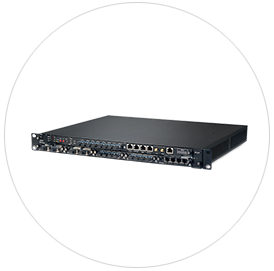
APN-50A
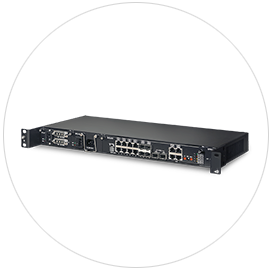
APN-20A
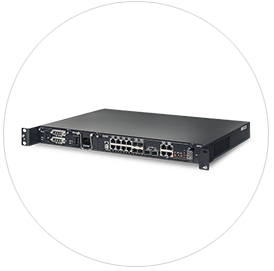
APN-20B
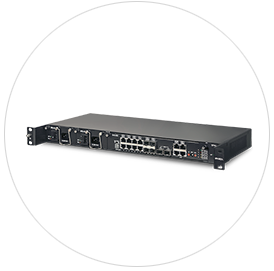
APN-20C
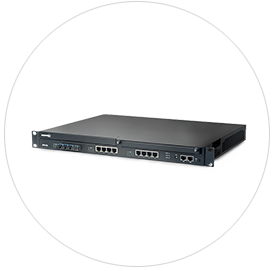
APN-10A
* APN : Advanced Packet Network
Specification
| Model | APN-50A |
APN-20A/B/C |
APN-10A |
|
| Composition | Common part | Main(1slot), Power part(2slot) |
||
| Channel part | Front side 5slot, Back side 2slot | Back side 5slot (E1/DS0)(B only) | Back side 1 slot (E1) | |
Switching Capacity |
Packet | 60Gbps |
32/14Gbps |
8Gbps |
Protection |
Network | MPLS-TP(G.8131) Linear Switching |
||
Service Interface | ||||
10GbE (XFP) |
4 Ports/Sys. (2Ports/Unit) |
2 Ports/Sys. (2Ports/Unit) |
|
|
GbE-FX (SFP) |
20 Ports/Sys. (8/4 Ports/Unit) |
6 Ports/Sys. (6 Ports/Unit) |
4 Port/Sys (4 Port/Unit) |
|
GbE-TX (RJ-45) |
20 Ports/Sys. (8/4 Ports/Unit) |
14 Ports/Sys. (14 Ports/Unit) |
8 Port/Sys (8 Port/Unit) |
|
100Base-FX (SFP) |
20 Ports/Sys. (8/4 Ports/Unit) |
6 Ports/Sys. (6 Ports/Unit) |
4 Port/Sys (4 Port/Unit) |
|
100Base-TX (RJ-45) |
20 Ports/Sys. (8/4 Ports/Unit) |
14 Ports/Sys. (14 Ports/Unit) |
8 Port/Sys (8 Port/Unit) |
|
STM-1(CES) |
4 Ports/Sys. (4 Ports/Unit) |
|||
DS1E (CES) |
16 Ports/Sys (16 Ports/Unit) |
6 Port/Sys (6 Port/Unit)(B only) |
16 Port/Sys (16/4 Port/Unit) |
|
DS0 (CES) (FXS/RD/TD/2WEM) |
16 Port/Sys (4 Port/Unit)(B only) |
|||
| Clock | INT / EXT / Sync-E / IEEE 1588v2 | INT/Sync-E |
||
Dimension |
W x H x D (mm) |
482.5 x 45 x 374(incL FAN) |
[A/C] 482.5 x 45 x 189.7 |
482.5 x 45 x 320(incL FAN) |
| Power Supply | DC/AC | -48VDC |
||
| Power Consumption (W) | 93 | 19.7 / 32.2 / 31.9 [A/8/C] | 40 | |
Advantages
- Continuity through function based on MPLS-TP standard technology
- · MPLS-TP Linear Protection (G.8131)
- · Protection switchover within 50ms
- Various services and flexible network topology
- · Ethernet interfaces (10GE, 1GE, FE), SDH and PDH interfaces(STM-1, E1)
- · Variety of topologies such as PTP, ring and mesh (G.8131 Linear protection)
- · Support PTN network based on MPLS-TP
- Optimized L2 function
- · UNI duplexing by setting 1 LAG of 2 units
- · Self loop detection for blocking looping obstruction of a port
- QoS for efficient traffic management
- · Maximization of bandwidth utilization by controlling CIR and PIR as 1 Mbps
- · Application of PHB MAP and QoS by CoS, DSCP setting
- · Quality control as services via offering 8 Queues per port
- Traffic statistics of services
- · Traffic management for each port and offering easier viewing graph of statistic information in database
- End to End service operating management
- · End to End service configuration by one click
- · Service configuration management by GUI
- Efficient operation
- · Direct monitoring and management with system configuration as like real equipment
- · Convenient functions including automatic creation of tunnel name, bandwidth variation, and path creation when network configuring
- System management
- · Offering statistical information on temperature of each unit and optical module function
- · Fan speed auto control function for efficient cooling of the equipment
Network Topology
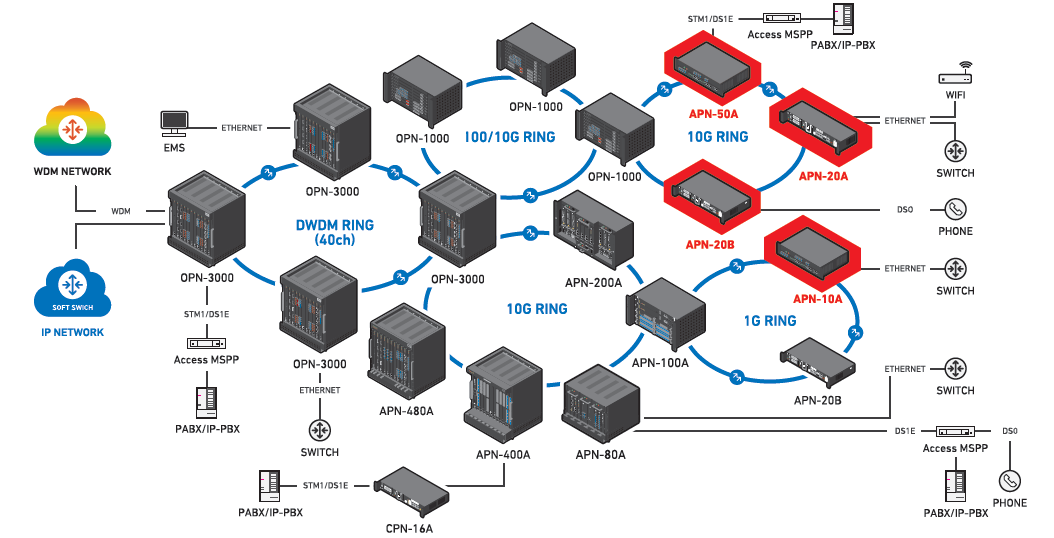
Packet Transport Network Circuit Emulation Service Extension System
The CPN system is a system that converts TDM services such as STM-1 / E1 into packets, By providing the PTN device and the extended structure through the Ethernet interface, the slot of the PTN device It increases availability. In addition, the LAG function provides an interworking port redundancy configuration.
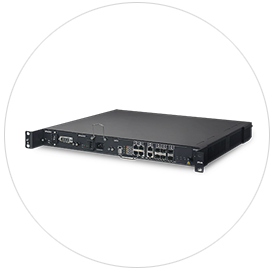
CPN-16A
Specification
| Model | CPN-16A |
|
| Composition | Common part | Main (1 slot), Power part(2slot) |
| Channel part | Back side 4slot | |
Switching Capacity |
Packet | 29Gbps |
Protection |
Network | LAG configuration |
Service Interface | ||
10GbE (XFP/SFP+) |
2 Ports/Sys. (2 Ports/Unit) |
|
GbE-FX (SFP) |
6 Ports/Sys. (6 Ports/Unit) |
|
STM-1(CES) |
32 Ports/Sys. (8 Ports/Unit) |
|
DS1E (CES) |
64 Port/Sys. (16 Ports/Unit) |
|
| Clock | INT / EXT / Sync-E | |
Dimension |
W x H x D (mm) |
482.5 x 45 x 374(incL FAN) |
| Power Supply | DC/AC | -48VDC/AC220V |
| Power Consumption (W) | 152 | |
Advantages
- Interworking PTN device by using LAG linkage
- · 10GE/1GE interface
- · Protection switchover within 50ms
- CES service extension
- · SDH(STM-1) interface
- · PDH(E1) interface
- Traffic statistics of services
- · Traffic management for each port and offering easier viewing graph of statistic information in database
- End to End service operating management
- · End to End service configuration by one click
- · Service configuration management by GUI
- Efficient operation
- · Direct monitoring and management with system configuration as like real equipment
- · Convenient functions including automatic creation of tunnel name, bandwidth variation, and path creation when network configuring
- System management
- · Offering statistical information on temperature of each unit and optical module function
- · Fan speed auto control function for efficient cooling of the equipment
Network Topology
